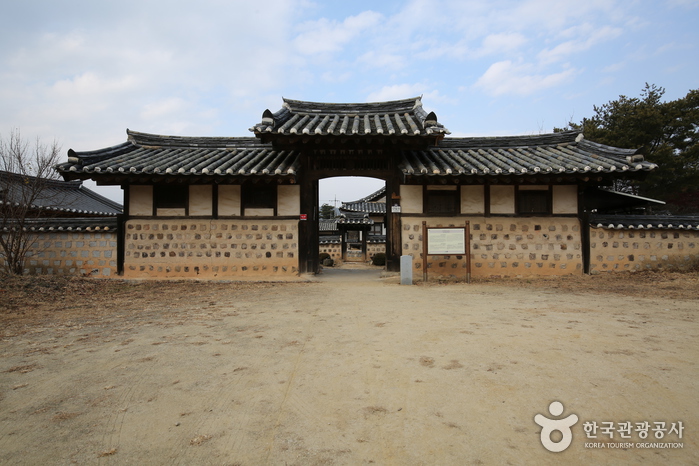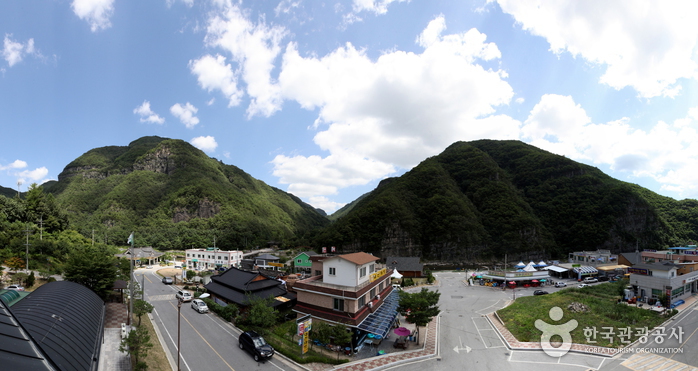Oryuheon House / 오류헌
17.6Km 2025-08-12
18-15, Gireumaje-gil, Andong-si, Gyeongsangbuk-do
Oryuheon House, located near Imhaho Lake in Andong, Gyeongsangbuk-do, offers a chance to stay in a historic house from the Joseon period. The house, also known as Mogwa House, was built by Kim Won-jung, the third son of Sukjong-era rector of the National Academy Kim Bang-geol, when he formed a family of his own in 1678. It was designated as the National Folk Cultural Heritage No. 184. The door’s wooden frame and the open floor space exemplify the beauty of the literati house of the Joseon period, while the sarangchae (men’s quarters) and daemunchae (gate quarters) showcase the sophisticated architecture of the era. Anchae (women’s quarters) retains its original appearance, while the sarangchae was rebuilt in 1920. The construction of the Imha Dam in 1990 resulted in the house’s relocation to its present location.
The owner of the house resides in anchae and sarangchae. Guests have access to a space that includes a 2-kan room, which can accommodate up to 4, an open floor space, and a bathroom. Cooking is prohibited in the house, but guests can make use of a grill located on a small yard reserved for the guests. Korean-style breakfast, including menus like chicken porridge or lotus leaf rice, are offered free of charge in the morning. Nearby sights include the water sports activities in Imhaho Lake, Manhyujeong Pavilion, Hahoe Village, and Dosanseowon Confucian Academy.
Suaedang / 안동 수애당
17.9Km 2025-08-12
1714-11, Sugogyonggye-ro Imdong-myeon, Andong-si, Gyeongsangbuk-do
+82-54-822-6661
'Suaedang Traditional House was built by Ryu Jin-geol, also known by his pen-name of Suae, in 1939. This hanok-style house consists of three buildings that measure 29-kan (a traditional measurement that corresponds to the space between two columns) in total.
The main room, or jeongchim (7-kan at front and 2-kan at sides), has a half-hipped roof, and forms a‘ㄱ’-shape with the storeroom (10-kan at front), which also has a half-hipped roof. Originally located at 612 Sugok-dong, Andong-si, the house was relocated from a slight slope to a flat piece of land due to the construction of Imha Dam in 1987. Consequently, the Jeongchim was rebuilt at a lower level than before.
The Suaedang was renovated by modernizing the old-style facilities including the kitchen, toilets, and washroom without changing their external features, while the rooms and daecheongmaru (main floored room) were decorated with red clay and natural paint. Suaedang, with its beautiful panoramic view of the lake, was designated as Gyeongsangbuk-do Cultural Property No. 56.
Parc provincial du Mt. Cheongnyangsan (청량산도립공원)
18.1Km 2022-08-10
39, Gwangseok-gil, Bonghwa-gun, Gyeongsangbuk-do
+82-54-679-6651
Le mont Cheongnyangsan a une altitude de 870 mètres et propose divers sites touristiques comme le pic Geumtapbong, les cascades Gwangchangpokpo, le temple Cheongnyangsa, etc. Derrière le rocher du parc provincial, on trouve un monument avec un poème inscrit par le célèbre savant Toegye Hwang I de la période Joseon appelé Cheongnyangsanga.
Dawoo Motel / 다우모텔
19.8Km 2025-08-12
66, Jangteojungang-gil, Andong-si, Gyeongsangbuk-do
+82-54-858-9100
Dawoo Motel is located in a lively street located in Pungsan-eup, Andong-si, and serves as a popular accommodation for visitors to Hahoe Village thanks to its affordable rates.
The five-story building houses 25 rooms, with the maximum occupancy of 50. The rooms are available in both Korean and bedroom styles. Bedrooms, which have beds and sofas, have a standard occupancy of 2 and a maximum of 3, while the twin room has a maximum occupancy of 4. Korean rooms have a standard occupancy of 2, but various ondol (under-the-floor heating system) rooms can house up to 5, 6, and 7 guests. Dawoo Motel thoughtfully requires no additional surcharge for additional guests in ondol rooms.
Not all rooms have bathtubs, so guests are advised to contact the front desk for their reservation. Guests are offered complimentary bottled water, beverages, and coffee. All rooms are furnished with TV, refrigerator, air conditioning, towels, basic toiletries, and hair dryer. Pets are allowed in the room, and services are also offered in English. Hahoe Village and Byeongsanseowon Confucian Academy, which were inscribed as UNESCO World Heritage, can be reached by car in 20 min.




 Français
Français
 한국어
한국어 English
English 日本語
日本語 中文(简体)
中文(简体) Deutsch
Deutsch Español
Español Русский
Русский